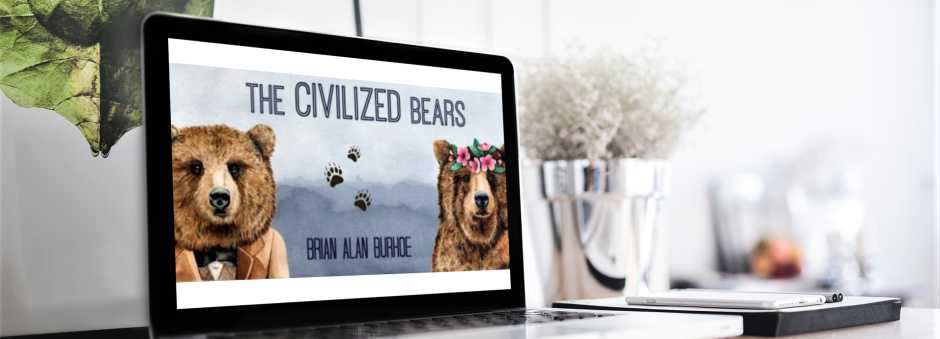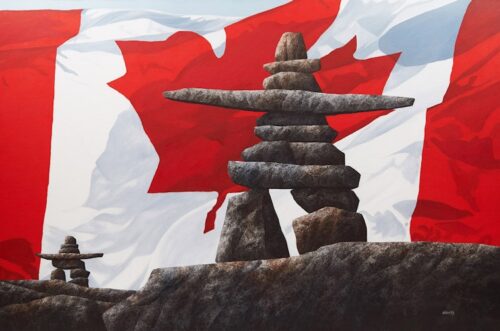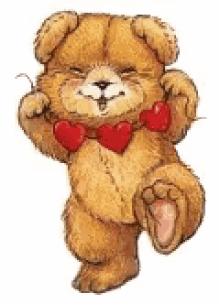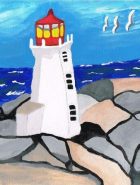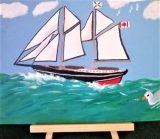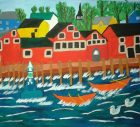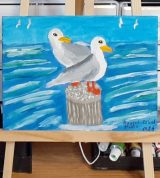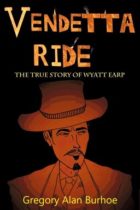Inukshuk Spiritual Meaning.
The Inukshuk. A Canadian Inuit art and signpost.
CANADIAN INUIT ART. From Animal Stone Carving to Inukshuk Figures — Spiritual Meaning
From smaller soapstone animal carvings to the BIG Inukshuk made of piled local rocks, Canadian Inuit sculptures are attracting attention. Worldwide attention.
We’ve long been aware that the Indigenous peoples of the Arctic Circle are unique. Those people are the Inuit, formerly known as Eskimo. They are part of an indigenous group spread across the High North of eastern Siberia, Alaska, northern Canada and Greenland.
They appeared in Canada about 5500 years ago. Until Farley Mowat (who had lived among them) released his PEOPLE OF THE DEER in 1952, little was known about them as a society.
Today, we know more. We certainly know about their artwork!
Here, from Clint Leung, is a knowledgeable look at these people and their stonework…
Materials Used In Inuit Sculpture and Inukshuk
Inuit artisans in Canada’s Arctic regions use raw materials that are found on the land. Or from the sea along the coasts. There are no trees up in the Arctic tundra. So wood was never an option as a raw material for Inuit sculpture and art. Instead, the Inuit artisans used whatever is available locally. Therefore stone is the most common material used for their Inuit sculpture. Followed by animal bone and ivory.
Stone For Inuit Sculpture and Inukshuk
Since stone is the most common raw material for Inuit sculpture, this is what the world usually sees from Inuit art. However, getting a good supply of quality stone isn’t always easy for Inuit carvers. Quarries or sites with good stone aren’t always located near the various Inuit communities.
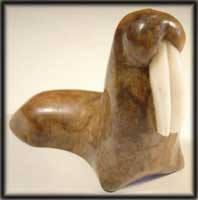
Inuit Stone Sculpture of Walrus
Inuit artists would often have to travel together to the quarries. By boat during the summer or by snowmobile during the winter. Sometimes trips can take several days. Getting the stone out of the land is hard physical labor. It has to be extracted with tools such as picks and drills. The stone cannot be simply blasted out with dynamite. Blasting would damage the stone. Once enough quality stone is extracted, the Inuit carvers would have to transport the supply back to their communities.
The Different Styles of Inuit Sculpture
At first glance, all Inuit soapstone sculptures from the Arctic may look alike. However, there are variances in artistic styles among the different Inuit art communities. While both animal and human images are common themes in Inuit art, some seem to do more animals while others do more people figures.
Some communities make their subjects appear quite realistic, with lots of high detail. In others, a more crude and primitive look is preferred. There are Inuit sculptures that have a highly polished finishes. And some that are the complete opposite where they are left dull and unpolished.
The popular Dancing Bear sculptures, for instance, usually have highly polished surfaces.
Contemporary Arctic Art Carvings
Some areas specialize in producing small scale miniatures. Which are much like the artwork by their ancestors who first came into contact with white men. Inuit sculpture can range from quietly naturalistic to bold or even wildly outrageous. Scenes can be playful like a piece depicting two Inuit children playing. Or with a sense of humour like a walrus waving at you. On the other end, transformation and shamanic pieces can look disturbing or even frightening to some viewers. Hunting scenes can portray the gory realities of life and death in nature.
There’s one theme in all Inuit sculptures. They show the fact that Inuit people have deep connections with their family life. And also depict their natural surroundings and spiritual beliefs.
Some Inuit artists have converted to Christianity. But many still include Inuit spirituality and legends as a big part of their lives. This is portrayed in some of their Inuit sculpture and other artwork.
Stones & Styles
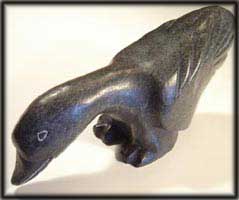
Inuit Stone Sculpture of Arctic Bird
The differences in artistic style are partly due to the different types of stone. As well as other materials available in each community. And there are regional preferences. Of course there can be outside influences when Inuit artists travel from community to community. This is particularly the case with larger growing communities like Iqaluit which has seen an influx of Inuit from other parts of Nunavut ever since becoming its capital. One can find a variety and blending of Inuit art styles here.
Western Arctic Region
Inuit sculpture from the western part of the Arctic are usually smaller in scale compared to artwork from other areas. Entire scenes made with multiple pieces attached are common. These scenes usually depict traditional life including camps, hunting, igloos and dog sleds. Ivory is used frequently here and sometimes pieces of copper are added. Especially to pieces from Kugluktuk (Coppermine). Holman is an Inuit community known for its art prints and the popularity of its annual releases rival to that of Cape Dorset
The Inukshuk: Structures & Carvings
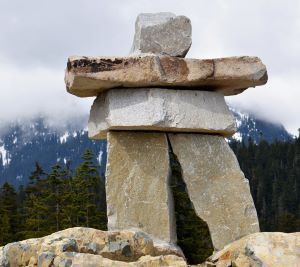
What Is An Inukshuk? The Inukshuk has been one of the most significant symbols of the Canadian Arctic north.
An inukshuk is a structure made of stones piled on top of each other. The word means “in the likeness of a Human.” Inuksuit figures are used for a number of reasons. In the white snowscape everything can look the same — a bleak, rolling sameness. The iconic stone figures stood out no matter what the season or weather.
The amazing Inukshuk has 4 purposes…
- Navigation: Inuksuit (plural of Inukshuk) help guide travelers through the frozen north
- Hunting: Inuksuit mark hunting and fishing spots. And can be used to create paths for hunting caribou
- Safety: Inuksuit warn of danger
- Reverence: Inuksuit mark sacred places
Many people buy and collect Inuit art as investments.
Inuit art is growing internationally. But it has been suggested that the number of actual Inuit artists are actually declining. Carving and the entire process of bringing back suitable stone from distant quarries to their own communities are hard work for Inuit art carvers. Many young Inuit prefer to pursue less physically demanding careers. Such as regular nine to five, weekday only government office occupations.
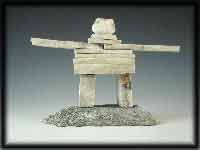
Inuit Arctic Inukshuk hand carving
Identifying Authentic Indigenous Art — The Igloo Tag
Authentic Inuit and Native Canadian artworks are unique. No two pieces are alike. Genuine Inuit carvings should be accompanied by an Igloo Tag. This tag is a Canadian government-registered trademark. It certifies that the piece is handmade by Inuit artisans. In 2017, the Inuit Art Foundation was given full control of this iconic trademark. Collectors are advised to purchase indigenous art from reputable galleries and dealers. This avoids inadvertently supporting the counterfeit market.
Clint Leung is the Founder of the Free Spirit Gallery.
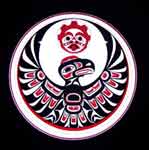 YOU’VE GOTTA SEE NORTHWEST CANADIAN INDIGENOUS ART HISTORY: Totem Poles, Thunderbirds, Eagle & the Wolf Mother
YOU’VE GOTTA SEE NORTHWEST CANADIAN INDIGENOUS ART HISTORY: Totem Poles, Thunderbirds, Eagle & the Wolf Mother
Further Reading:
- “An inuksuk (plural inuksuit) or inukshuk is a type of stone landmark or cairn built by, and for the use of, Inuit, Iñupiat, Kalaallit, Yupik…” Inuksuk
- An inukshuk is a stone formation traditionally built by the Inuit. Originally spelled inuksuk, the word inukshuk means “to act in the capacity of a Human’… What Is An Inukshuk? | History – Cultural Elements
